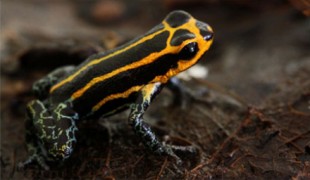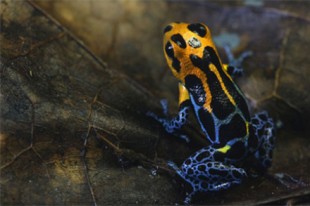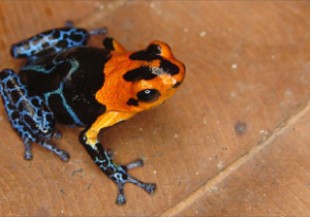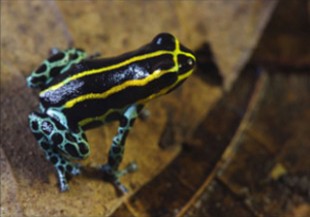In Difficult Times Good People gravitate towards Absolute Truth
Peruvian Evolution
Publisher's note: The author of this post, Doug Boyd, is a contributor to ECU News Services.
Researchers at East Carolina University have discovered that certain populations of a South American frog species have changed their appearance to avoid predators through mimicry of other species, causing the populations to diverge – possibly to the point of evolving into two different species.
 Their findings, published in late August in the journal Nature Communications, could signal a major advance in evolutionary biology.
Their findings, published in late August in the journal Nature Communications, could signal a major advance in evolutionary biology.
"The species that we study (Ranitomeya imitator, the Peruvian mimic poison frog) is unusual in that different populations of this one species have evolved to resemble (mimic) four distinct 'model' species in different geographic regions in northern Peru," said Kyle Summers, an ECU biology professor and expert in evolution.
"The different mimetic morphs are very different in appearance, having striped, banded, spotted or 'Varadero' color patterns," said Summers. Varadero is the village near where researchers discovered the frogs.
Summers said the work involved long-term, intensive research on multiple aspects of the species, including morphology, behavior, acoustics, ecology, biogeography, population genetics and evolution. During the past five years, graduate student Evan Twomey, who is lead author on the research article, spent many months in Peru overcoming numerous challenges to gather and analyze data.

 "Specifically, the collecting done for this project was difficult simply because the main study site was so remote," Twomey said. "It could only be reached by river, and it was normally a six-to-eight-hour ride in a motorized dugout canoe. I feel like it's really a testament to the biodiversity of the region that we're able to make discoveries such as this."
"Specifically, the collecting done for this project was difficult simply because the main study site was so remote," Twomey said. "It could only be reached by river, and it was normally a six-to-eight-hour ride in a motorized dugout canoe. I feel like it's really a testament to the biodiversity of the region that we're able to make discoveries such as this."
The results of this research provide "strong evidence" that mimicry is driving population divergence and new speciation between two populations of the Peruvian poison frog, Summers said. The frogs have evolved to mimic two different model species that are distinct from each other in color and pattern.
"This connection between mimicry and speciation has only been demonstrated in one other group of organisms – Heliconius butterflies – and never in a vertebrate," said Summers. "Hence, the results of this study represent a major advance in evolutionary biology."
Summers said the next step in the research is to determine exactly what genes have changed and what impact those changes have.
In addition to funding from the National Science Foundation and the National Geographic Society, Twomey and Summers' research was supported by the Thomas Harriot College of Arts and Sciences at ECU.
The research article is online at http://www.nature.com/ncomms/2014/140827/ncomms5749/full/ncomms5749.html.


Model species pictured above are the striped Ranitomeya variabilis from the lowlands at right and Ranitomeya fantastica from near Varadero, left. (Contributed photo)

Research by ECU biology professor Kyle Summers, pictured above, and graduate student Evan Twomey has uncovered a frog species that protects itself from predators through mimicry of other 'model' species. (Photo by Cliff Hollis)
Go Back
Research shows mimicry in frogs can engender new species
Researchers at East Carolina University have discovered that certain populations of a South American frog species have changed their appearance to avoid predators through mimicry of other species, causing the populations to diverge – possibly to the point of evolving into two different species.

Evan Twomey
"The species that we study (Ranitomeya imitator, the Peruvian mimic poison frog) is unusual in that different populations of this one species have evolved to resemble (mimic) four distinct 'model' species in different geographic regions in northern Peru," said Kyle Summers, an ECU biology professor and expert in evolution.
"The different mimetic morphs are very different in appearance, having striped, banded, spotted or 'Varadero' color patterns," said Summers. Varadero is the village near where researchers discovered the frogs.
Summers said the work involved long-term, intensive research on multiple aspects of the species, including morphology, behavior, acoustics, ecology, biogeography, population genetics and evolution. During the past five years, graduate student Evan Twomey, who is lead author on the research article, spent many months in Peru overcoming numerous challenges to gather and analyze data.


Pictured above are the morphs of R. imitator that are the focus of the Nature Communications paper. At top is the striped R imitator and at the bottom is the Varadero morph. (Contributed photo)
The results of this research provide "strong evidence" that mimicry is driving population divergence and new speciation between two populations of the Peruvian poison frog, Summers said. The frogs have evolved to mimic two different model species that are distinct from each other in color and pattern.
"This connection between mimicry and speciation has only been demonstrated in one other group of organisms – Heliconius butterflies – and never in a vertebrate," said Summers. "Hence, the results of this study represent a major advance in evolutionary biology."
Summers said the next step in the research is to determine exactly what genes have changed and what impact those changes have.
In addition to funding from the National Science Foundation and the National Geographic Society, Twomey and Summers' research was supported by the Thomas Harriot College of Arts and Sciences at ECU.
The research article is online at http://www.nature.com/ncomms/2014/140827/ncomms5749/full/ncomms5749.html.


Model species pictured above are the striped Ranitomeya variabilis from the lowlands at right and Ranitomeya fantastica from near Varadero, left. (Contributed photo)

Research by ECU biology professor Kyle Summers, pictured above, and graduate student Evan Twomey has uncovered a frog species that protects itself from predators through mimicry of other 'model' species. (Photo by Cliff Hollis)
| Durham Shreds Gun Registry Records | East Carolina University, School News, The Region, Neighboring Counties | ECU Alumna, Former Soccer Star New Face Of American Athletic Conference |





















